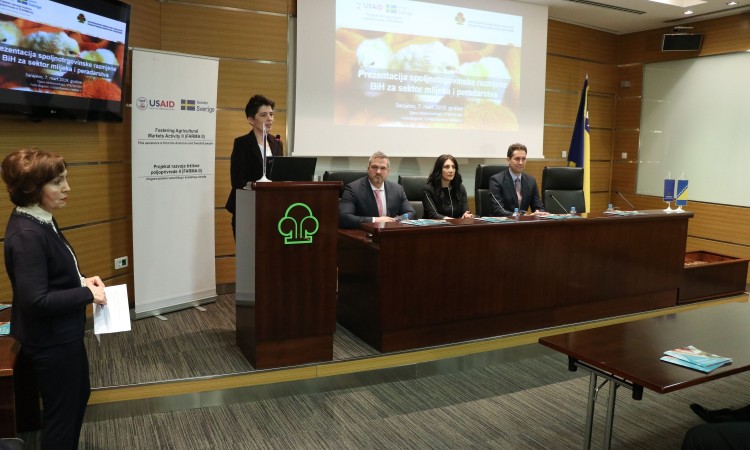
Bosnia maintained a trade surplus throughout the past year despite poultry exports dropping by two percent, according to a USAID/Sweden FARMA II project and the State Foreign Trade Chamber presentation on Thursday.
Dairy exports also grew by 17 percent, reaching 89 million marks (some €49 million), the speakers said, adding that imports are also growing.
The export-import coverage also rose from 54 to 58 percent.
The deficit was still high and amounts to 65 million marks (approx. € 33 million) because the total imports reached 154 million (some € 72 million).
On the other hand, Bosnia’s poultry sector recorded a two percent drop in exports and a 16 percent rise in imports. In spite of this, Bosnia still has a 15 million mark surplus (some € 7.5 million). The 2018 poultry exports amounted to 54 million marks (some 25 million) while imports reached 39 million marks (around € 20 million).
The head of the USAID Mission to Bosnia and Herzegovina, Peter Duffy, said that despite this data, the country still managed to make progress in both fields.
“On behalf of the USAID and the Swedish Embassy to Bosnia, I’m happy to say there’s progress in the dairy and poultry sector. Bosnia’s milk exports recorded a significant export growth to Montenegro and Serbia, especially from the Republika Srpska (RS) entity,” Duffy said.
Montenegro continued to be the biggest dairy export market in 2018, with high export growth of 37.7 percent compared to 2017.
The FARMA II project and Bosnia’s Foreign Trade Chamber said that the Croatian market recorded a significant import drop of Bosnia’s dairy products. Bosnia’s exports dropped from 15 million marks (some € 7.5 million) to 9 million marks (some € 4.5 million), which is a 38 percent drop. They say that the reason for this is that Slovenia and Hungary offered much cheaper dairy products than those coming from Bosnia.
Another major problem to Bosnia’s dairy export growth is Kosovo’s introduction of 100 percent tariffs to all Bosnian and Serbian products in November 2019. As a result, Bosnian exports dropped by 74 percent by December 2018.
Speaking about the poultry sector, Bosnia’s most important export market in 2018 was North Macedonia, with 15 million marks (some € 7.5 million). Serbia was the second most important export market worth 14 million marks, while Kosovo imported 12 million marks (some € 6 million) worth of poultry from Bosnia. Montenegro was the fourth with 11 million marks (approx. € 5.5 million) worth of poultry exports. These four markets contributed to 97 percent of total poultry exports from Bosnia and Herzegovina.
The FARMA II project and the Foreign Trade Chamber warned that unless Kosovo suspends its tariffs, Bosnia could experience a significant export drop which would affect its entire poultry sector.
Kakvo je tvoje mišljenje o ovome?
Učestvuj u diskusiji ili pročitaj komentare





 Srbija
Srbija
 Hrvatska
Hrvatska
 Slovenija
Slovenija



























































